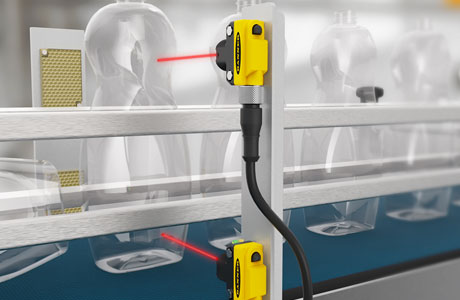Key Takeaway
Photoelectric sensors use an emitter to send a light beam and a receiver to detect it. When an object interrupts or reflects the light, the sensor recognizes this change, detecting the object’s presence.
Unlike proximity sensors, photoelectric sensors can detect various materials, such as glass, plastic, wood, and liquids. This versatility makes them useful in industrial automation and safety systems where different objects need to be detected accurately.
The Basic Mechanism of Light Detection in Photoelectric Sensors
At the heart of a photoelectric sensor is a simple but ingenious concept: light detection. These sensors work by emitting light, typically from a light-emitting diode (LED), toward a target. When the light beam hits the target, it reflects back to the sensor’s receiver. This interaction allows the sensor to detect the presence or absence of an object.
The simplicity of this process might make it seem basic, but the precision with which these sensors operate makes them incredibly valuable in industrial applications. The moment the beam is interrupted by an object, the sensor converts this change into an electrical signal, triggering the desired action, whether it’s stopping a conveyor belt or activating a safety mechanism.
Short sentences make this clearer: Light is emitted. It hits the target. It reflects. But what’s crucial is the timing and accuracy with which this process happens, ensuring efficiency and safety in high-speed environments.

Types of Light Used in Photoelectric Sensors (Visible, Infrared)
In photoelectric sensors, visible and infrared light are the two main types used for detection. Visible light, being something humans can see, offers the advantage of easy monitoring. For environments where operators need to visually check the sensor, visible light is often preferred. However, this type of light is prone to interference from ambient light sources like sunlight or factory lighting, which can lead to inaccurate readings or false triggers. This makes visible light sensors less reliable in harsh, high-precision environments.
Infrared light, on the other hand, is invisible to the human eye and more commonly used in industrial settings. Since infrared light is not affected by surrounding light sources, it provides more accurate detection, especially in outdoor or dimly lit areas. Its ability to cut through dust, smoke, or fog further enhances its reliability. Understanding the differences between these light types is crucial when selecting the right sensor for your application, ensuring smooth and uninterrupted operations even in challenging environments.
How Sensors Convert Light Into Electrical Signals
The magic of photoelectric sensors lies in their ability to convert light into electrical signals. When a beam of light—whether visible or infrared—reaches the sensor’s receiver, typically a photodiode, it triggers a reaction. The photodiode is designed to detect this light and create an electrical current when activated. The current generated is proportional to the light detected, meaning the brighter the light, the stronger the signal.
This electrical signal is then processed by the sensor’s internal circuitry. Depending on the application, the signal can either activate machinery, halt operations, or trigger alarms. It all happens within milliseconds, ensuring fast and efficient responses. For a newly joined engineer, think of it as the sensor “seeing” light and immediately “talking” to the system, providing instructions to take action. This seamless process is vital in ensuring industrial systems work smoothly and without delay.
Factors that Affect Light Detection in Industrial Settings
In industrial environments, multiple factors can influence the effectiveness of photoelectric sensors. One of the main challenges is environmental interference—dust, smoke, or steam can obstruct the light beam, leading to reduced accuracy. Additionally, too much light from nearby sources can create interference, causing the sensor to misread or trigger false detections.
Distance between the sensor and the object being detected is also a critical factor. The farther the object, the harder it becomes for the sensor to accurately detect it, especially in environments filled with interference. Choosing a sensor with the right beam range and sensitivity adjustments is essential. For example, some sensors allow you to fine-tune their sensitivity to meet specific needs, improving detection accuracy in challenging conditions. These considerations can significantly improve system reliability and prevent costly interruptions.
The Role of Photodiodes and Light Receivers in Sensing Technology
Photodiodes are the unsung heroes behind every photoelectric sensor’s function. They are engineered to be extremely sensitive to changes in light levels. When a light beam, either visible or infrared, hits the photodiode, it excites the electrons, creating an electrical current. This is how the sensor “sees” light and starts processing the information.
Light receivers, another crucial component, filter out unnecessary light and focus solely on the sensor’s emitted beam. Advanced sensors are designed to differentiate between the light from the sensor and stray light from external sources. This capability is particularly vital in environments where multiple sensors operate in close proximity, as it prevents false signals. Without these photodiodes and precise receivers, industrial processes would face frequent interruptions. Accurate sensing technology ensures smooth operation, even in high-demand settings.
Conclusion
Photoelectric sensors, which operate by detecting changes in light, are essential components in automating industrial processes. By converting light into electrical signals, they enable precise control in various applications, such as object detection, positioning, and counting. Understanding their functionality and the impact of factors like light type and environmental conditions is crucial for ensuring their reliability. Mastering these sensors not only helps in proper installation and troubleshooting but also optimizes their use, enhancing overall efficiency and safety in industrial operations.
